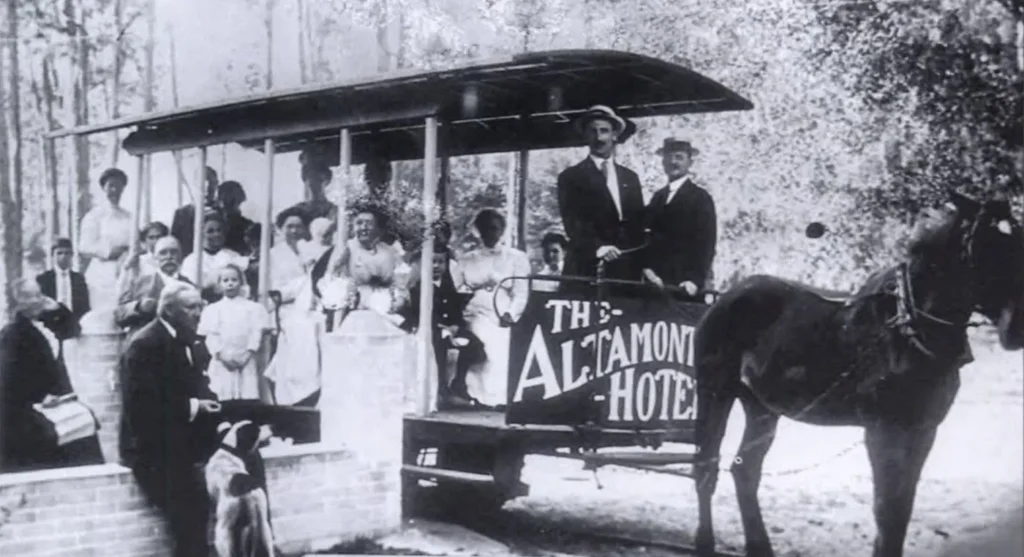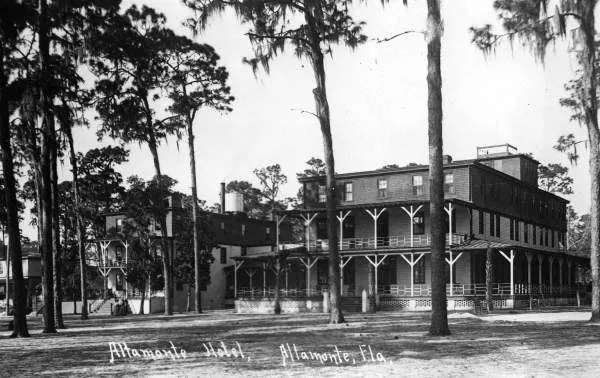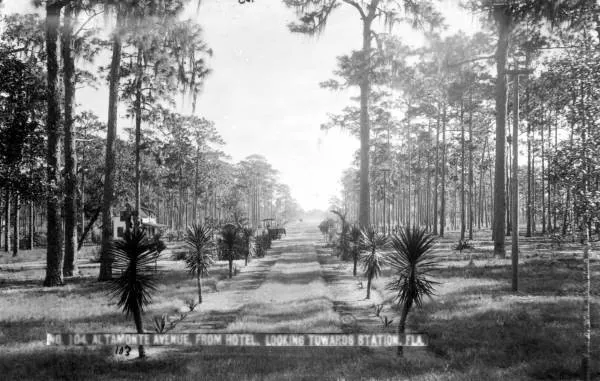A horse-drawn street car ushered guests from the train station to the Altamonte Hotel from its founding in 1883 until 1925, when the storied transport came to an abrupt halt.

In 1882 a group of Boston area investors founded the Altamonte Land Hotel and Navigation Company, intending to create a winter resort for northern guests. They succeeded a year later in constructing their crown jewel: The Altamonte Hotel.
The majestic resort was built on a park-like setting of over 1200 acres between lakes Orienta and Adelaide. The hotel sat precisely in the middle of the intersection of Highway 436 and Maitland Avenue. The hotel and accompanying bungalows had guest accommodations of 150 rooms. It was surrounded by a few residential homes, staff residences, and a first-rate restaurant on campus. Guests had access to free private citrus groves, a nine-hole golf course, tennis, boating, the famous springs, and even an in-house orchestra at nightly dances.

Snowbird guests arrived from their northern homes via the South Florida Railroad, which stopped at Snowville Station — which soon became known as Altamonte Springs — starting in 1880. Upon disembarking, there was a half-mile trek down Altamonte Avenue to arrive at the resort.
From those earliest days, the most popular route was by street car. A narrow-gauge rail ran to the hotel’s porch from the depot (in the same spot as the modern Sun Rail station). The original horse’s name was Dixie, so the vehicle became known affectionately as the “Dixie Flyer.”

For over forty years, it became one of the most identifiable parts of the experience for incoming guests and the horsecar was well known throughout the region. Sitting just in front of the hotel when not in use, the carriage was sort of a trademark of the place, almost like the monorails or lake boat fairies are today to transport guests to Disney’s Magic Kingdom.
Like many resorts in the south, the Altamonte only operated for half of the year. The place shut down during the summer months, as the guests returned north for the season, and would re-open each December.
In the fall of 1925, the opening date was December 1st. It was the height of Florida fever, with the land boom and roaring 20s in full effect. The season was already looking to be one of the busiest on record, with the hotel essentially booked solid well in advance.

On November 14, hotel staffers, surely looking to get a jump on preparing the grounds for guests arriving in just two weeks, awoke to a shocking sight: the Dixie Flyer was… gone! Understand this was no standard horse-and-buggy. It was a rail-mounted street car. Imagine the frenzy (and confusion) as they looked up and down the half-mile tramway between the hotel grounds and the train station. All signs indicated it had vanished into thin air!
But of course, things such as trolley cars do not simply evaporate. There had to be an explanation… and there was. Not much later, reports reached Altamonte Springs that the flyer had reappeared seven and a half miles away in front of the girls’ dormitory at Rollins College.
It seems a prank, no doubt led by a mischievous (and possibly drunk, despite prohibition) band of male co-eds, was to blame. Sometime after midnight that Saturday morning, the unnumbered crew of vandals arrived at The Altamonte and hoisted the famed vehicle right off its rails.
How exactly from there it came to rest in Winter Park is a bit of a mystery. But by necessity, it included a good bit of pushing, pulling, dragging, or maybe towing the car over the sand and brick roads of Altamonte Springs, Maitland, and Winter Park. It likely ended with an exhausted cadre of (hopefully sore and deservedly hung over) college men.
As if the hefty transport wasn’t enough to satisfy their naughty sense of comedy, their night of vandalism concluded with the Flyer’s complete destruction. The roof was removed from the heavy trolley and its seats were scattered. It was deemed beyond feasibility to repair and the historic cab was forever retired.
This author does not know whether the perpetrators were ever identified and punished. But I surely hope they were or at least came to feel very guilty about it with the wisdom that maturity brings!
For decades there was discussion about recreating the famed vehicle — even after the Altamonte Hotel burned down in 1953. It was still seen to be a highly identifiable symbol of the town’s legacy. However, the reincarnation of the Dixie Flyer never came to be. Project anyone?!





